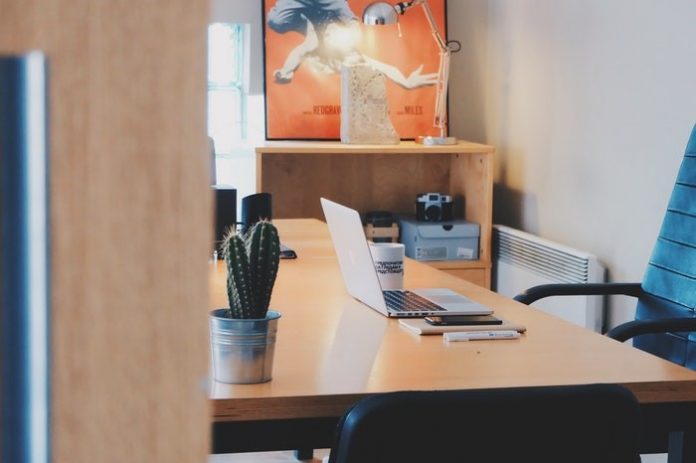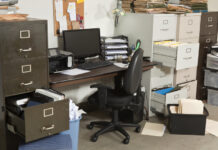Disorganization actually costs you more time than you might think, so it may be worth considering spending the necessary time to organize your office space. It’s not enough to rearrange and move piles of paperwork around on your desk every once in a while. It’s also not enough to just move the mess elsewhere, like a drawer or a box. If you have a neat and well-ordered office area, it allows for increased productivity and reduces time-wasting and procrastinating.
If you’re now looking at your messy office space in despair, don’t organizing your office isn’t a task that needs to take days and be done all at once. In fact, you can do little bits at a time, like it’s an ongoing project. We’ve compiled organization tips below that will help you tackle your office cleanup to increase your efficiency.
1. Purge everything first
Before starting the reorganization process, you have to purge everything you currently have cluttering your desk. If you don’t need it, shred it, toss it, delete it. Tackle one area at a time and think about whether you’ve used that item recently, or if it has corporate value to the business. This applies to furniture, equipment, and other supplies, as well as decorations and flowers — if they’re dusty, clean, replace or remove them as they make your office look less than neat.
2. Separate your office into zones
Divide your office into different areas — where you work, where your reference material, and supplies are stored. Gather up all your stuff in your office and redistribute it where it belongs according to these zones. Place the equipment and supplies that you use the most in close proximity to you, and others that you use less frequently can be stored appropriately.
3. Establish a good filing system
It’s important to develop a good filing system for both paper files and electronic ones. In terms of paper filing, consider what can be stored digitally and what needs to stay printed. Do you have any duplicates that you can eliminate?
A good filing system can have a few different folders based on importance and need:
- A meeting folder: everything that needs to be discussed at meetings, reports to submit, files to distribute, etc. It’ll save you stress of scrambling before the start of a meeting as you’ll know exactly where to look.
- A WOR folder: keep everything that is waiting on a response (WOR) from someone else in the same folder. Check it every day or two to see if you need to follow up.
- Storage boxes: keep storage boxes for various needs to keep important archived files separate from your work space. Include a separate box for magazines or binders that you need to keep, and reading material that you’d like to get to but isn’t urgent. Make sure everything in these boxes is actually useful and needed; if not, recycle them or give them away.
It’s critical to file regularly. Make this a habit, such as once weekly, so it never piles up and becomes too daunting of a task.
Also, the more files that can go paperless, the better. This is especially true for little things like notes, post its, and individual pieces of paper. Use applications for note taking and file sharing online.
Lastly, don’t forget to design a filing system for your inbox as well. People spend way too much time in the email inbox, and this can be just as cluttered and overwhelming as a physical desktop. Unsubscribe from newsletters you don’t need, delete what doesn’t have an enduring value, and create filters for incoming emails.
4. Label, label, label!
Get a good label maker, and label everything! It will save you a lot of time and will help your colleagues find things without interrupting you. Label all your drawers and cabinets, and storage file folders. You can also label all your wires for your computer, monitor, space heater, phone charger, printer, etc. to save you time and a headache if something goes wrong. While you’re at it, hide all your wires behind your desk to reduce the appearance of clutter at your workstation.
Finally, label your computer files and your inbox. Sort your files and emails by project and clearly identify drafts and final version.
5. Organize your desk space
Make sure your filing system is organized, using trays, or containers to keep your desk space clear. Come up with a paper mail station for your colleagues who need to drop off files. Hang a mailbox or folder on your wall to keep it off your desk. If you find you’re running out of desk space, create an under shelf basket. This is a simple basket that hangs under the desk to put away your necessities so you’re not always hitting something or knocking something over while you type.
Another great idea to clear even more desk space if you have tall cubicle walls or sit by a wall is to store things on the wall. As previously mentioned, you can create a mailbox, or install a pegboard to hang office supplies. It can also be quite easy and inexpensive to install a shelf or two for those supplies, freeing up key real estate on your desk.
6. Organize your drawers
There are some easy ways to organize your drawers, by installing dividers for your various files. This prevents you from simply dumping everything in your drawers, and moving the clutter from one area of your workspace to another.
Consider creating an office library that I’d centrally located where you can store all the reference books and binders that you don’t consult often but which are important for the business. This is an idea that will not only clear your desk drawers but that all colleagues can benefit from.
7. Daily workflow tips
Finally, it can be helpful to your overall organization skills to adopt a few simple practices in your daily work life to keep your office space clear. Automate any recurring task to avoid wasting time on them, and keep a notepad with a daily task to do list which is more helpful than a plain lined notepad.
At the end of every day, take two minutes to straighten everything up — it will make a huge difference to your peace of mind, especially when you arrive in the morning to a clear, uncluttered desk.
Find a Home-Based Business to Start-Up >>> Hundreds of Business Listings.

















































